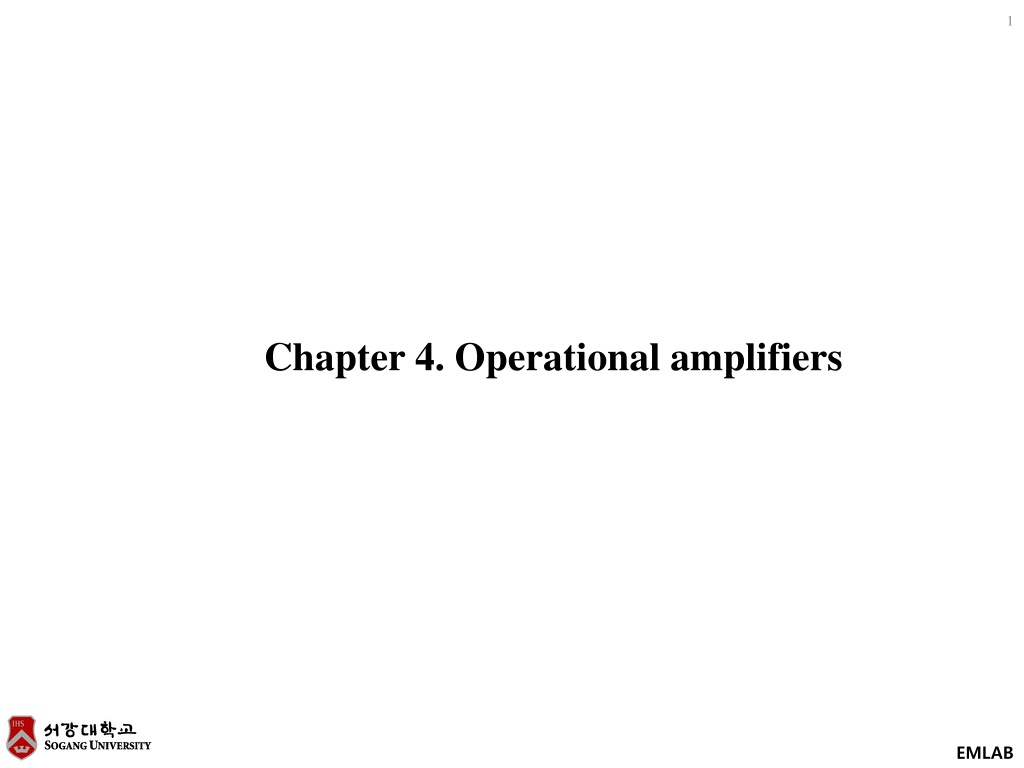
Operational Amplifiers: Introduction, Models, and Applications
Dive into the world of operational amplifiers with this comprehensive guide covering topics such as op-amp models, fundamental circuits, comparators, and various application and design examples. Explore why op-amps were originally designed for mathematical operations and how they have evolved to become essential components in modern electronics. Gain insights into ideal and non-ideal op-amp configurations through detailed examples and learn about operational amplifier circuits and their functionalities.
Download Presentation

Please find below an Image/Link to download the presentation.
The content on the website is provided AS IS for your information and personal use only. It may not be sold, licensed, or shared on other websites without obtaining consent from the author. Download presentation by click this link. If you encounter any issues during the download, it is possible that the publisher has removed the file from their server.
E N D
Presentation Transcript
1 Chapter 4. Operational amplifiers EMLAB
Contents 2 1. Introduction 2. Op-Amp Models 3. Fundamental Op-Amp Circuits 4. Comparators 5. Application Examples 6. Design Examples EMLAB
Why operational amplifiers ? 3 1. Originally, the op-amp was designed to perform mathematical operations such as addition, subtraction, differentiation, and integration. 2. By adding simple networks to the op-amp, we can create these building blocks as well as voltage scaling, current-to-voltage conversion, and myriad more complex applications. EMLAB
2. Op-amp model 4 Ideal op-amp : ?? , ?? 0, ?0 ??? 0, ??? 0 ??? EMLAB
Example 5 ?? ?? ?? ?? = ?0 ?0 ??+ ?? 1 ??+ ?? EMLAB
Example : unity gain buffer 6 ??= ?(??+ ??+ ??) + ?0??? ??= ???+ ?0??? ???= ??? ?? ?? ???+ ?0??? ???+ ?0??? = = 1 ?(??+ ??+ ??) + ?0??? ?(??+ ??+ ??) + ?0??? ?? ?? EMLAB
Example 4.2 7 Let us determine the gain of the basic inverting op-amp configuration shown in the figure using both the non-ideal and ideal op-amp models ?1 ?? ?1 ?0 ?1 ?2 +?1 +?1 ?? ?2 = 0 ?? +?? ??? ?? = 0 ?0 ?? ?2/?1 1 ?2+1 ?2 ?1 = 1 ?1+1 ?2+1 1 ?2 1 ?2 ? 1 ?? ?? ?? EMLAB
8 Ideal model ? ? 0 [?] Virtual short ??= ??2 ?? = ?2 ??= ??1, ?? ?1 Step 1. Use the ideal op-amp model: Ao , Ri , Ro= 0. i+= i-=0, v+= v- Step 2. Apply nodal analysis to the resulting circuit. Step 3. Solve nodal equations to express the output voltage in terms of the op-amp input signals. EMLAB
Example 4.3 9 Let us now determine the gain of the basic non-inverting op-amp configuration shown in the figure. ? ?+= ??? ??? ?? =?0 ??? ?? 1 ?? 1 =?0 ??? + ?? ?? ?0 ??? = 1 +?? ?? EMLAB
Example 4.5 10 Consider the op-amp circuit shown in the figure. Let us determine an expression for the output voltage. ?4 ? ?+= ?2 ?3+ ?4 ?1 ? ?1 =? ?? ?2 ??= ? ?2 ?1(?1 ? ) = ?2 ?1?1+ 1 +?2 ?3+ ?4?2=?2 ?4 ?1(?2 ?1) ?1 ( ?4= ?2, ?3= ?1) EMLAB
Example 4.6 11 The circuit shown in the figure is a precision differential voltage-gain device. It is used to provide a single-ended input for an analog-to-digital converter. We wish to derive an expression for the output of the circuit in terms of the two inputs. ?1 ?? ?2 ?2 ?? ?1 +?1 ?? ?1 +?2 ?1 ?? +?1 ?2 ?? +?2 ?2 = 0 = 0 ??= (?1 ?2) 1 +?2 +2?2 ?? ?1 EMLAB
Example 4.7 12 ?1 ?? 10? + 30???=?? 10? ?1 ?2 10? ?1 ?2+ ?1 ??= 2?1 ?2 ?0 +?1 ?? 10? ??= 4 = 0 4= 0 ??= 8?1 4?2 EMLAB
4.4 Comparators 13 (a) An ideal comparator and (b) its transfer curve. (a) A zero-crossing detector and (b) the corresponding input/output waveforms. EMLAB
Application example 4.11 14 An instrumentation amplifier of the form shown in Fig. 4.26 has been suggested. This amplifier should have high-input resistance, achieve a voltage gain Vo/(V1-V2) of 10, employ the MAX4240 op-amp listed in Table 4.1, and operate from two 1.5 V AA cell batteries in series. Let us analyze this circuit, select the resistor values, and explore the validity of this configuration. ?? 2 ?1 ?2 ?? ?? ?? ?? 2 ?? ?? =?2 ?? ?2 ?? ?1 ?1 =?1 ?2 2 = ??= ?? ?? ? EMLAB
15 ??= ?1+?1 ??= ?2 ?2 ?(?1 ?2), ?(?1 ?2) ??= 1 +?1 ?1 ?1 ??= ?2 ??1+ 1 +?2 ??2, ?2 ? ? ??= ?? ??= ??= 1 +?1+ ?2 (?1 ?2) ? ?? = 1 +2?1 = 10 ( ?1= ?2) ?1 ?2 ? ?1= 4.5? ??) ? = 100 ? , ?1= 450 ? EMLAB
Design example 4.14 16 We wish to design a weighted-summer circuit that will produce the output Vo= - 0.9V1 - 0.1V2 The design specifications call for use of one op-amp and no more than three resistors. Furthermore, we wish to minimize power while using resistors no larger than 10k . ?? ?1+ ?2= ?? ?1 ?1 +?2 ?2 =0 ?? ? ??= ? ?1?1 ? ?2?2 ? ?+= 0 ? ?1 ? ?2 ? ? = 0.9, = 0.1 ?1= 0.9, ?2= 0.1 ??. ? = 270 [ ], ?1= 300 [ ], ?2= 2.7 [? ], EMLAB
